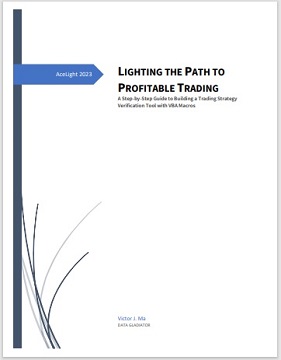Cracking the Code:
Why Different Stock Trading Strategies Yield Different Results?
|
|
They say there's no one-size-fits-all when it comes to clothing, and the
same can be said for stock trading strategies. You can't just pick a
strategy off the rack and expect it to fit perfectly, no matter how tempting
it may be to sport the latest trend. Trust me, I tried that once with
parachute pants in the 80s and it didn't end well. The same holds true for
trading strategies - what works for your buddy Bob may not work for you, and
what worked yesterday may not work today. In fact, the only thing that seems
to work consistently in the stock market is Murphy's Law: Anything that can
go wrong, will go wrong. So, buckle up, strap on your trading helmet, and
let's explore why different stock trading strategies will get different
results.
Stock trading can be a tricky business. The market is
unpredictable, and even the most seasoned traders can struggle to make
consistent profits. One of the reasons for this is that different stock
trading strategies can yield vastly different results. Some strategies
prioritize long-term gains, while others focus on short-term profits. Some
rely on technical analysis, while others use fundamental analysis.
Day trading, for example, involves buying and selling stocks within a single
day, often using technical indicators to identify short-term price
movements. Swing trading, on the other hand, involves holding onto stocks
for a few days to a few weeks in order to capture longer-term price trends.
Value investing is another popular strategy, which involves identifying
undervalued stocks and holding them for a long period of time in the hopes
that their value will eventually be recognized by the market. Growth
investing, on the other hand, involves identifying companies that are
expected to grow at a faster pace than the overall market and investing in
them for potential long-term gains.
While there is no guaranteed way
to make money in the stock market, understanding different trading
strategies and their potential risks and rewards can help investors make
informed decisions and develop a trading plan that aligns with their goals
and risk tolerance.
Different stock trading strategies can lead to
varying outcomes due to the fact that the stock market is constantly
changing and unpredictable. What works in one market condition may not work
in another. Additionally, the same strategy can produce different results
for different investors, as each investor's goals, risk tolerance, and
investment timeline may differ.
For example, a day trader may be able
to make quick profits by taking advantage of short-term price movements, but
they also risk losing money if the stock price moves against them. On the
other hand, a value investor may have to wait a longer period of time for
their stocks to appreciate in value, but they are less likely to be affected
by short-term price fluctuations.
Another factor to consider is the
type of analysis used in the strategy. Technical analysis involves analyzing
charts and past price trends to identify patterns and predict future price
movements. Fundamental analysis, on the other hand, involves examining a
company's financial statements, management, and industry to determine its
intrinsic value and growth potential.
Each strategy has its own
strengths and weaknesses, and investors must choose the one that aligns with
their investment goals and risk tolerance. It's important to thoroughly
research and understand each strategy before implementing it, and to
continuously monitor and adjust the strategy as market conditions change.
Even within the same trading strategy, the parameters used can greatly
impact the results. For example, a day trader who uses technical analysis
may use different indicators or timeframes to determine when to buy or sell
a stock. By changing the parameters, they may get vastly different signals
and therefore, different results.
Similarly, a value investor may use
different criteria to determine whether a stock is undervalued, such as
price-to-earnings ratio, price-to-book ratio, or dividend yield. Each
criterion can produce different results, and the investor must determine
which criteria are most important to them and adjust their strategy
accordingly.
The use of leverage can also greatly impact the results
of a trading strategy. Leverage involves borrowing money to increase the
size of a position, which can amplify both gains and losses. While leverage
can increase potential returns, it also increases risk, and investors must
be careful not to take on too much leverage and risk losing more than they
can afford.
It's important to note that while tweaking parameters
within a trading strategy can potentially improve results, it can also lead
to over-optimization or curve-fitting. This occurs when the parameters are
too finely tuned to historical data, and may not perform as well in future
market conditions. As a result, it's important to use backtesting and
simulation tools to test the performance of a strategy over different market
conditions before implementing it in live trading.
Even with the same
strategy and parameter settings, applying it to different particular stocks
can produce vastly different results. This is due to the fact that each
stock has its own unique characteristics and is affected by different market
forces. For example, using the famous "Golden Cross and Death Cross" trading strategy and after back-testing it over a 10-year period, it could potentially yield an annual ROI of up to 48% for Tesla stock. However, when applying the same strategy to Apple stock, another reputable and well-established company, the theoretical annual ROI drops down to 18%.
More details, please take a look at this
comparison.
For example, a day trader who uses technical analysis to
identify short-term price movements may have success trading volatile stocks
that have high trading volume, but may struggle to generate profits when
trading stocks with low liquidity or that are heavily influenced by external
factors, such as regulatory changes or global events.
Similarly, a
value investor who focuses on identifying undervalued stocks may have
success with certain industries or sectors that are currently undervalued or
have strong growth potential, but may struggle to find undervalued stocks in
industries that are already highly valued or facing headwinds.
 In
addition, a stock's performance can be impacted by factors beyond the
control of the investor, such as company news, macroeconomic trends, or
unexpected events. This means that even the best-designed trading strategies
can fail if market conditions change unexpectedly. That's why we've
emphasized many times that for serious stock investors, testing is
everything. For more
information about the Testing, Click
LIGHTING THE PATH TO PROFITABLE TRADING: A Step-by-Step Guide to Building a Trading Strategy Verification Tool with VBA Macros to get the whole tutorial handbook for free! In
addition, a stock's performance can be impacted by factors beyond the
control of the investor, such as company news, macroeconomic trends, or
unexpected events. This means that even the best-designed trading strategies
can fail if market conditions change unexpectedly. That's why we've
emphasized many times that for serious stock investors, testing is
everything. For more
information about the Testing, Click
LIGHTING THE PATH TO PROFITABLE TRADING: A Step-by-Step Guide to Building a Trading Strategy Verification Tool with VBA Macros to get the whole tutorial handbook for free!
And click Free Trial to download strategies testing tools, all for a 30-day Free Trial.
It's important for investors to diversify their portfolios and not
rely too heavily on a single trading strategy or stock. By spreading their
investments across different stocks and strategies, investors can minimize
their risk of losses and increase their chances of generating consistent
returns over the long term.
So, what can traders do to improve their chances of success? First and
foremost, it's important to have a solid understanding of your own skills,
preferences, and risk tolerance. This will help you choose a trading
strategy that is well-suited to your individual needs. It's also important
to test your strategy over different market conditions to ensure that it is
robust and not over-optimized to historical data.
So, there you have
it folks - the secret to success in the stock market is simple. Just find a
strategy that works for you, tweak the parameters until your eyes glaze
over, diversify your portfolio, and pray to the trading gods that your lucky
rabbit's foot is working. And if all else fails, just remember the immortal
words of Yogi Berra, "In theory, there's no difference between theory and
practice, but in practice, there is." So, go out there and put your theories
into practice, and who knows, you just might become the next stock trading
superstar. Happy trading!
|


|

Free Tutorial
Share
|
|
|
|